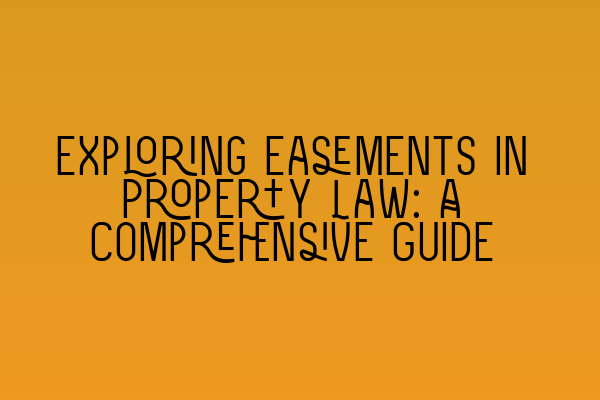Exploring Easements in Property Law: A Comprehensive Guide
When it comes to property law, there are various legal concepts and principles that come into play. One such concept is easements, which play a crucial role in determining the rights and limitations of property owners. In this comprehensive guide, we will explore easements in property law, discussing their definition, types, creation, termination, and important considerations for property owners. So, let’s dive deeper into the fascinating world of easements.
What are Easements?
An easement is a legal right granted to a person or party to use another person’s land for a specific purpose. It creates a non-possessory interest in the land, allowing the holder of the easement to enjoy certain rights without ownership. Easements are often granted to ensure the efficient use and enjoyment of land, as well as to facilitate necessary access and utilities.
Types of Easements:
Easements can be categorized into several types based on their nature and purpose. Let’s explore the most common types of easements:
1. Appurtenant Easements:
Appurtenant easements occur when the right of use benefits a particular piece of land, known as the dominant tenement, by providing access or utility services from a neighboring property, known as the servient tenement. These easements “run with the land,” meaning they bind and benefit subsequent owners of the dominant and servient tenements.
2. Easements in Gross:
Easements in gross are easements that do not benefit a particular piece of land but instead grant a personal right to an individual or entity. They are often used in utility or railway easements, where a company or organization is granted the right to use the land for a specific purpose.
3. Prescriptive Easements:
Prescriptive easements arise when a person openly, continuously, and without permission uses another person’s land for a specific purpose for a statutory period of time. If the requirements for acquiring a prescriptive easement are met, the person can legally claim the right to continue using the land for the specified purpose.
4. Easements by Necessity:
Easements by necessity are created when a landowner is completely or partially landlocked and requires an easement to access their property. These easements are deemed necessary for the reasonable use and enjoyment of the land and are often granted by the court.
Creating an Easement:
An easement can be created in several ways, with each method offering different legal requirements and implications. Here are the common ways of creating an easement:
1. Express Grant:
An easement can be expressly granted by the owner of the servient tenement through a written agreement or deed. This agreement should clearly outline the rights and limitations of the easement, including any restrictions or conditions imposed by the grantor.
2. Express Reservation:
An easement can also be reserved when the owner of the servient tenement transfers the property but retains certain rights over it in favor of themselves or a third party. This reservation should be explicitly stated in the conveyance document.
3. Necessity:
As mentioned earlier, an easement by necessity can be created by the court when a landowner is landlocked and requires an easement to access their property. The court will consider the essentiality of the easement for reasonable use and enjoyment of the land.
4. Implication:
An easement can be implied when it is necessary for the use and enjoyment of a property but not expressly granted or reserved. This often occurs in situations where a property is divided, and certain rights are reasonably expected to exist considering the prior use of the land.
Termination of Easements:
Easements can be terminated through various means, depending on the circumstances and the parties involved. Here are some common ways in which easements can be terminated:
1. Expiration:
Some easements have a specific duration or expiration date mentioned in the agreement or deed. Once the specified period ends, the easement is terminated, and the rights associated with it cease to exist.
2. Merger:
If the dominant and servient tenements become vested in the same owner, the easement is said to merge, and the rights granted by the easement are extinguished. This commonly occurs when the owner of both properties purchases the servient tenement.
3. Release:
An easement can be terminated through a written release provided by the holder of the easement. The release should be executed with all necessary formalities and clearly state the intention to terminate the easement.
4. Abandonment:
If the holder of the easement demonstrates a clear intention to abandon it, such as through non-use and neglect for an extended period, the easement may be deemed abandoned and terminated. The determination of abandonment usually depends on the specific facts and circumstances of each case.
Important Considerations for Property Owners:
As a property owner, understanding the implications of easements is vital to protect your rights and interests. Here are some important considerations to keep in mind:
1. Review the Title:
Before purchasing a property, conduct a thorough review of the title to identify any existing easements. This will help you understand the restrictions and benefits associated with the property.
2. Seek Legal Advice:
If you are unsure about the implications of an existing or proposed easement on your property, seek legal advice from a qualified property law solicitor. They can provide you with the necessary guidance and ensure your rights are protected.
3. Negotiate and Draft Agreements Carefully:
If you are granting or acquiring an easement, carefully negotiate and draft the agreement to clearly define the rights and obligations of each party. Include any necessary restrictions, conditions, and termination clauses to safeguard your interests.
Understanding easements in property law is crucial for anyone involved in property ownership or transactions. By grasping the concepts and intricacies of easements, property owners can make informed decisions and protect their rights. If you would like further guidance or legal assistance regarding easements or any other property law matters, feel free to contact our team of expert solicitors.
Related Articles:
